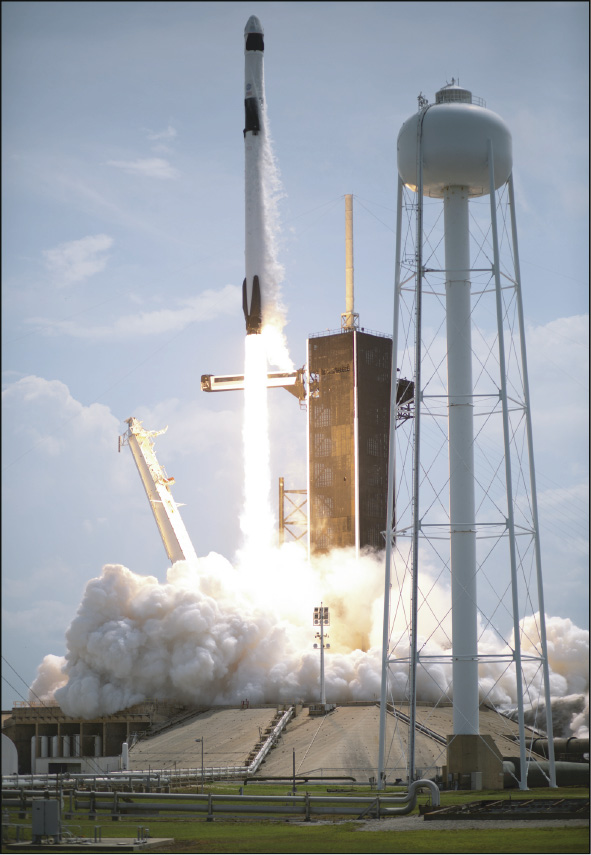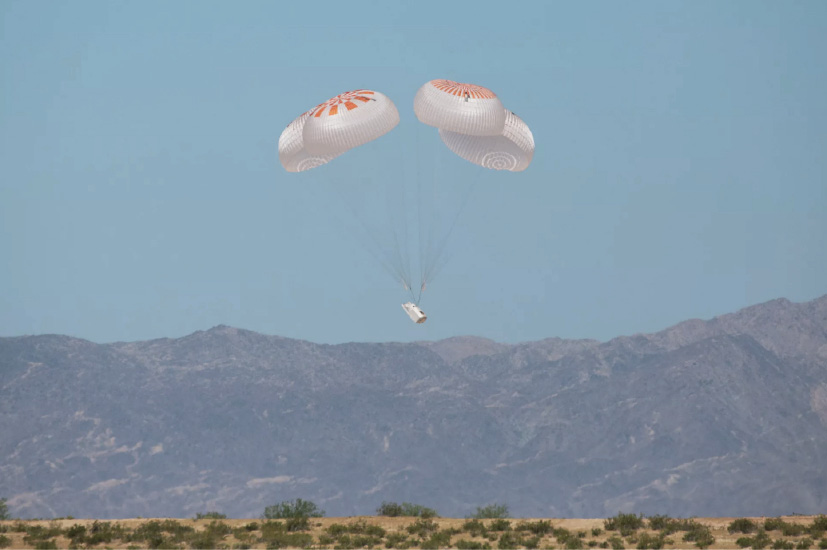On 30 May 2020, two National Aeronautics and Space Administration (NASA) astronauts, Robert Behnken and Douglas Hurley, made history as the first two people to travel to the International Space Station (ISS) aboard a private spacecraft (Fig. 1). Nine weeks later, on 2 August 2020, the SpaceX (Hawthorne, CA, USA) built and operated Crew Dragon returned Behnken and Hurley back to Earth, safely completing the mission.
《Fig. 1》

Fig. 1. The SpaceX Crew Dragon capsule that took astronauts Robert Behnken and Douglas Hurley to the ISS launched from NASA’s Kennedy Space Center in Florida on 30 May 2020. Credit: NASA (public domain).
"Only three nations have had human launch capabilities to Earth orbit: Russia, the United States, and China,” said Casey Dreier, senior space policy adviser and chief advocate at the Planetary Society, headquartered in Pasadena, CA, USA. ‘‘SpaceX is now part of that very small club.”
The mission, in which the Crew Dragon (Fig. 2) docked with the ISS, marks the first time that a rocket carrying US astronauts has launched from American soil since the Space Shuttle program ended in 2011. For the last nine years, all of NASA’s astronauts had hitched their rides to the ISS aboard Russian spacecraft at a cost of up to 90 million USD per person—35 million USD more than what SpaceX charges [1]. "It’s been a source of some embarrassment to the United States for NASA to not be able to launch its own astronauts and have to rely on the Russians,” said Laura Forczyk, owner of the space consulting firm Astralytical, headquartered in Atlanta, GA, USA. SpaceX’s lower price stems in large part from the substantial savings associated with the company’s unprecedented success in another first technical achievement: the return and reuse of its rocket components [2].
For the first half century of its existence, NASA contracted out the work of building its rockets to private aerospace firms while overseeing every aspect of production and design. NASA would then own, operate, and maintain the completed vehicles. When it was announced in 2004 that the Space Shuttle program would be defunded, NASA began looking for a less expensive replacement so they could reallocate funding toward other high priority missions, including deep space exploration. What the agency came up with was a public–private collaborative program called Commercial Orbital Transportation Services (COTS) [3].
COTS selected SpaceX as one of its original providers to deliver cargo to the ISS in 2006. COTS funding helped the company finance the development of its Cargo Dragon capsule and Falcon 9 rocket. SpaceX went on to launch numerous commercial satellites using the Falcon 9, as well as 20 resupply missions to the ISS since 2012 [3]. SpaceX has also launched dozens of satellites with its Falcon Heavy rocket. Currently the world’s most powerful rocket, the Falcon Heavy combines three Falcon 9 boosters [2].
《Fig. 2》

Fig. 2. The Crew Dragon spacecraft is checked after arriving at NASA’s Kennedy Space Center on 13 February 2020. Credit: SpaceX (public domain).
Given the success of Falcon 9, NASA officials created a similar program for transporting humans. In 2014, in addition to SpaceX, NASA selected longtime NASA contractor Boeing (Chicago, IL, USA) to make vehicles to send astronauts to the ISS. While both companies experienced significant setbacks—SpaceX’s Falcon 9 rocket blew up in 2015 and again in 2016 and Boeing’s CST-100 Starliner capsule suffered numerous software failures during its first unmanned trip to space in 2019—as of early 2020 it was still uncertain which company would be the first to fly crew to the ISS [4].
Yet, it has been the relative newcomer that has firmly asserted itself as the frontrunner of the commercial space industry. "NASA placed a big bet on SpaceX—and industry, in general—being able to deliver,” Dreier said. "And this launch definitely paid that bet off.”
Among the last systems on SpaceX’s test checklist before getting the go ahead to send astronauts to the ISS was the Crew Dragon capsule’s in-flight abort system. Should the Falcon 9 rocket experience an abnormal launch—caused by factors such as engine failure or tank rupture—the abort system would activate four small engines to jettison the capsule, with the astronauts inside, safely away from the rocket [4]. Boeing’s Starliner capsule uses a similar launch abort system, as do the Soyuz and Shenzhou crewed capsules operated by Russia and China, respectively. NASA’s Mercury and Apollo spacecraft also used such a system, but the Space Shuttle notably did not [5]. In April 2019, a Crew Dragon capsule exploded during an abort system test in which a slug of liquid propellant slammed into a titanium valve, causing it to ignite. Extensive modification and testing of the system culminated in a successful in-flight abort test in January 2020 [6].
The final component that SpaceX had to test for certification of the Crew Dragon was its four-piece parachute system that would bring the gumdrop-shaped capsule gently back to Earth (Fig. 3). In an effort to understand why an earlier version of the parachute inflated asymmetrically, leading to an April 2019 crash [7], SpaceX installed sensors within its parachutes to measure loads as they deployed and used that data to update the parachutes’ design. Following more than two dozen tests of the system in late 2019 and early 2020, the company announced the successful completion of its final parachute test on 1 May 2020, just weeks ahead of its eventual crewed launch date [7].
"The US space industry has traditionally been very conservative because it has really aligned itself around NASA,” said Marco Caceres, a space analyst with the Teal Group, an aerospace and defense industry analysis firm based in Fairfax, VA, USA. "SpaceX has been much more aggressive in its culture and they have been willing to push the envelope in terms of technological advancements.”
《Fig. 3》

Fig. 3. The Crew Dragon uses a four-piece parachute system, shown here in a test, to bring the capsule gently back to Earth. Credit: SpaceX (public domain).
Caceres said that SpaceX’s most important innovation has been engineering their Falcon rockets to land vertically back on Earth after deploying their payload so that they can be reused, which other rockets do not do [2]. In addition to substantially reducing costs, the company’s ability to reuse their rockets allows SpaceX to launch more frequently, and therefore innovate more quickly.
SpaceX also manufactures many of its own parts, making it less reliant on a distributed supplier network. This vertical integration allows the company to make design changes without a significant delay in production. The company also borrows a production-line mindset from another company launched by founder Elon Musk—the electric vehicle and battery manufacturer, Tesla (Palo Alto, CA, USA). ‘‘Through his experience with Tesla, Musk knows how to create efficiencies and economic incentives through the creation of a production line, as opposed to creating one-off specialty hardware,” Caceres said.
Beyond the company’s approach to design and production, SpaceX has a distinct advantage in attracting talented engineers, said Dreier, referencing Musk’s goal of colonizing Mars. "SpaceX has a certain sheen—it is the cool place to be,” he said. "You are making rockets to go to Mars to save humanity, and that type of organizing principle allows them to really pull in the best people and gives them a definite edge over Boeing.”
As for what is up next for SpaceX, the company has announced that it is getting into the space tourism business, joining a number of competitors, including Blue Origin and Virgin Galactic, which has already flown people on suborbital flights [8]. SpaceX has sold four seats aboard the Crew Dragon to send private citizens on a trip around the Earth in 2021 [9]. It is also working with a startup company called Axiom (Houston, TX, USA) to shuttle customers to the ISS [10].
Based on the success of Crew Dragon, NASA has decided to lean on industry for human missions to the Moon. The space agency awarded preliminary contracts in April 2020 to SpaceX and two other companies to develop a lander to bring humans to the lunar surface by 2024 [11].
And SpaceX is already working on an enormous new rocket called Starship that it hopes will one day take humans to Mars. "They don’t want to build just one or two of these; they want to be able to crank a ton of these off the production line,” Dreier said. "If it actually works in the next three or four years, each one will be far bigger than anything we’ve ever built in history.”













 京公网安备 11010502051620号
京公网安备 11010502051620号




